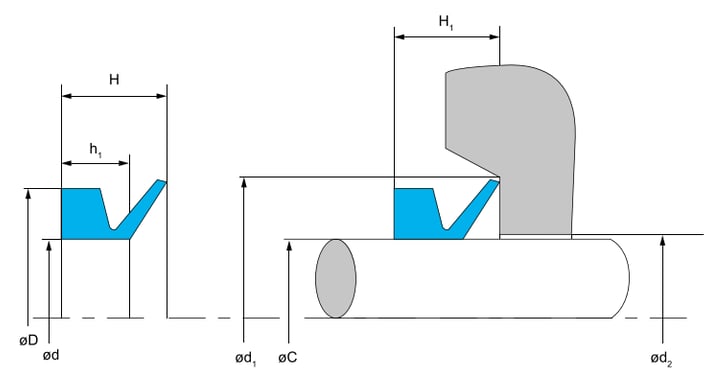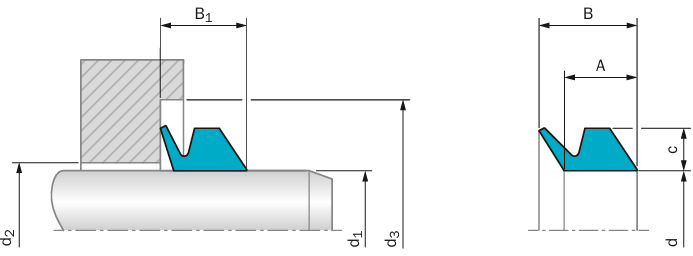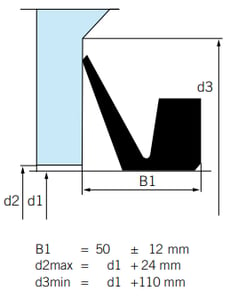V-ring sealing rings
V-ring seals are classified as rotating shaft seals and, unlike simmering type seals, they seal in the axial direction at the face of the seat (e.g., bearing - fixed element) while they themselves rotate with the shaft.
They consist of an annular rubber body, sometimes reinforced with a metal ring that fastens the ring to the shaft, and a sealing lip that rotates in a vertical plane to the shaft axis. The initial axial clamping, coming from the tension of the appropriately shaped rubber lip, causes contact pressures to occur. They are capable of operating in dusty environments.
Being made of FDA-approved materials, they can be used in the food industry.
Advantages:
V-rings protect against penetration of contaminants (dust, dirt, water)
V-rings can be used with other seals, e.g.: external protection of shaft seal (simmering) against contamination or sealing against leakage of fluids from the circuit
can be used for large eccentric movements of the shaft relative to the housing
tightly fitting and clamping on the shaft, the seal body does not require very precise machining of the shaft for proper operation
Versatility and variety of applications
Possible FDA approval
Principal use:
V-rings are popularly used in a variety of industries, including hydraulic, pneumatic and mechanical systems
offer effective and economical protection against contamination
There are the following types of V-rings:
V-ring Type A
Type A V-ring with an angled back serves as a non-pressure, axial shaft seal with a very short installation length that is clamped to the shaft.
The flexible sealing lip seals the opposite surface at right angles to the shaft, preventing dirt, dust and splashes from entering the structure.
Characteristics of the seal:
material type: NBR FPM
color: black brown
hardness: 60° Shore A 60° Shore A
Working conditions:
temperature: NBR: -40 to +100 °C / FPM: -25 to +200 °C
pressure: NBR: ≤ 0.03 MPa / FPM: ≤ 0.03 MPa
rotation speed: ≤ 8 m/s
from 8 to 12 m/s, radial support is recommended.
At speeds above 15 m/s, the edge will come off the front surface.
Material:
NBR - good chemical resistance to most of the samarium and mineral oils found on the market
FPM - good chemical resistance to mineral and synthetic oils and greases, gear oils, engine oils. Resistance to many chemicals and solvents. Resistance to aromatic and chlorinated hydrocarbons.
Application:
shaft sealing: electric motors, pump gearboxes, electric saws, agricultural machinery gearboxes, bearings for washing machines and other houseware products




Dimensions of V-rings type A:
V-ring Type L / XL:
The V-ring type L / XL with straight back serves as a non-pressure, axial shaft seal with a very short installation length that is clamped onto the shaft.
The flexible sealing lip seals the opposite surface at right angles to the shaft, preventing dirt, dust and splashes from entering the structure.
Sealing characteristics:
material type: NBR
colour: black
hardness: 60° shore A
Working conditions:
temperature: NBR: -40 to +100 °C
pressure: NBR: ≤ 0.03 MPa
rotation speed: ≤ 8 m/s from 8 to 12 m/s, radial support is recommended.
At speeds above 15 m/s the edge will come off the front surface.
Material:
NBR - good chemical resistance to most samarium and mineral oils on the market
Application:
shaft sealing: electric motors, pump gearboxes, electric saws, agricultural machinery gearboxes, bearings for washing machines and other white goods.


Dimensions V-rings Type L / XL:


V-ring Type S:
The S-type V-ring with a bevelled ridge serves as a non-pressure, axial seal on the shaft, which is clamped onto the shaft.
The flexible sealing lip seals the opposite surface at right angles to the shaft, preventing dirt, dust and splashes from entering the structure.
Characteristics of the seal:
material type: NBR FPM
color: black brown
hardness: 60° Shore A 60° Shore A
Working conditions:
temperature: NBR: -40 to +100 °C / FPM: -25 to +200 °C
pressure: NBR: ≤ 0.03 MPa / FPM: ≤ 0.03 MPa
rotation speed: ≤ 8 m/s
from 8 to 12 m/s, radial support is recommended.
At speeds above 15 m/s, the edge will come off the front surface.
Material:
NBR - good chemical resistance to most of the samarium and mineral oils found on the market
FPM - good chemical resistance to mineral and synthetic oils and greases, gear oils, engine oils. Resistance to many chemicals and solvents. Resistance to aromatic and chlorinated hydrocarbons.
Application:
shaft sealing: electric motors, pump gearboxes, electric saws, agricultural machinery gearboxes, bearings for washing machines and other white goods.


Dimensions V-rings Type S:


V-ring Type E
The Type E V-ring with straight back serves as a non-pressure, axial shaft seal with a very short installation length that is clamped onto the shaft.
The flexible sealing lip seals the opposite surface at right angles to the shaft, preventing dirt, dust and splashes from entering the structure.
Characteristics of the seal:
material type: NBR FPM
color: black brown
hardness: 60° Shore A 60° Shore A
Working conditions:
temperature: NBR: -40 to +100 °C / FPM: -25 to +200 °C
pressure: NBR: ≤ 0.03 MPa / FPM: ≤ 0.03 MPa
rotation speed: ≤ 8 m/s
from 8 to 12 m/s, radial support is recommended.
At speeds above 15 m/s, the edge will come off the front surface.
Material:
NBR - good chemical resistance to most of the samarium and mineral oils found on the market
FPM - good chemical resistance to mineral and synthetic oils and greases, gear oils, engine oils. Resistance to many chemicals and solvents. Resistance to aromatic and chlorinated hydrocarbons.
Application:
Type E is designed for intensive use or is applied in situations where greater axial tolerances are required. This profile is supplied for shafts from Ø450 to Ø2010 mm.’


Dimensions V-rings Type E:


Certificates and approvals for the food industry:
Certificates and material approvals (Elastomers):
FDA 21. CFR 177.2600
FDA 21. CFR 177.2400
EG/EC 1935/2004
EC 2023/206
USP class VI to +121 °C <88>
EU 2011/65/EU (ROHS)
EU 1907/2006 (REACH)
ADI-Free
